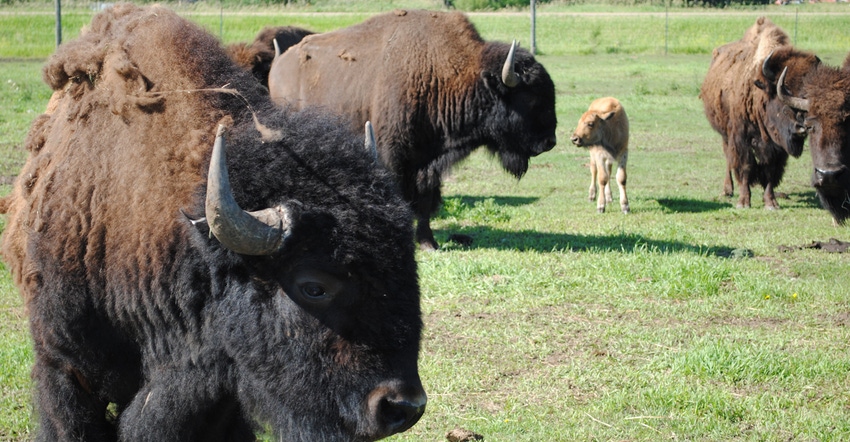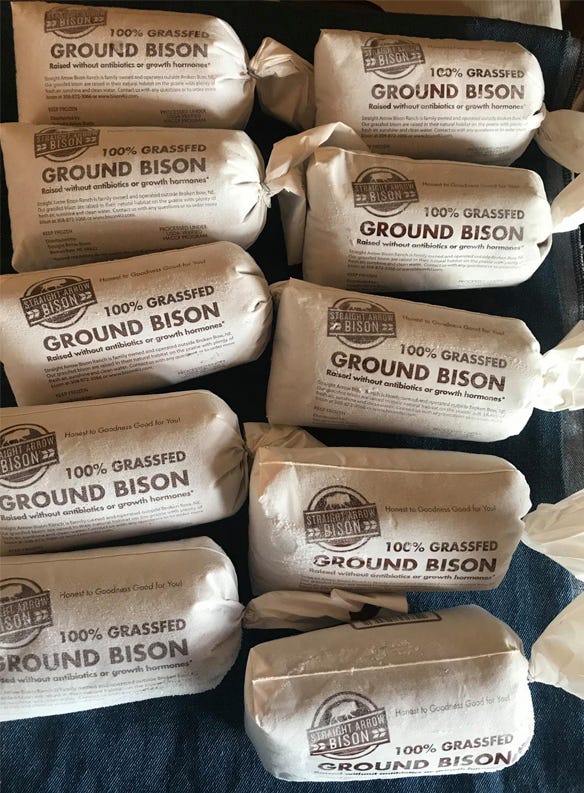
For centuries, the Nebraska prairies have been known as a natural home for bison. Maybe that’s why Nebraska ranks second only to South Dakota in total bison production.
For the pastures south of Broken Bow, Neb., owned by Marty and Karen Bredthauer of Straight Arrow Bison Ranch, that natural fit hasn’t changed. After the farm crisis of the 1980s, the family was looking for an enterprise on the land that would offer profit and be something they could work on together.
Their quest started with a family vacation to Fort Robinson State Park in 1993. As their interest in bison piqued, the Bredthauers talked with those who managed Fort Robinson’s sizable bison herd, and the family started to research the possibilities.
The family purchased their first four buffalo — a 6-year-old cow, a 3-year-old bull, a yearling bull and a heifer calf — in 1994. That summer, the cow had a heifer calf of its own, so the herd was growing.
Mobile cabin
Today, the Bredthauers run 24 cows, 3 herd bulls, 18 yearlings and 21 calves on their ranch. “We just finished butchering 18 2-year-olds,” Marty says. “That seems to be an ideal herd size for the amount of grass and pasture we have. Our herd is completely grass-fed from May to January, and then supplemented with prairie hay.”
Marketing their products has been a unique adventure for the family. “We are not marketers by training, so it requires effort on our part to keep going,” Karen says. They market the majority of their meat through a mobile cabin — Straight Arrow Bison’s answer to a food truck — which makes once-monthly trips to Grand Island, Kearney and North Platte, and bimonthly trips to McCook.
Lone Tree Foods distributes Straight Arrow’s meat in the Lincoln and Omaha areas, and Wildflour Grocer stocks its products in its store in O’Neill. Straight Arrow also sells and ships through a website.
“We have had a set schedule for many years that includes the first Saturday of the month at Grand Island; the second Saturday, Kearney; third Saturday, North Platte; and every other month we go from North Platte to McCook,” Karen says.
“Kearney and North Platte have farmers markets that we partner with during the market season, usually June through October. At first, we thought we would take winters off from selling, but we had people calling, wondering when we were going to be back. So now we continue our marketing throughout the year.”
“We try to keep our location consistent, so customers know where to find us,” she adds. “We started in Grand Island going to Kmart. When that closed, we were able to move down the street to Sam’s Club. The Kearney and North Platte locations coincide with the farmers markets, and we are able to continue using these areas after the markets close for the winter.”

HEALTHFUL MEAT: Bison at Straight Arrow are grass-fed from May to January and supplemented on prairie hay the rest of the year. Straight Arrow began its direct-marketing bison meat business in 1994.
From the beginning, the plan was to sell their homegrown bison directly to customers. They have also worked hard to insulate loyal customers from the ups and downs of the bison market.
“From the start, our marketing plan was to sell the meat,” Karen says. “Although our prices for meat have gone up over the 25-plus years we have been in business, they do not fluctuate with market changes. If we have an overstock of something, we run specials and give samples.”
Takes patience
The family all takes part in the operation. All of the children were involved as they were growing up, but these days, it is mostly just Marty and Karen.
“Our son who lives close by is willing to check on things when we are gone and is a big help when we need to run them through the chute to tag them,” Karen says. Tagging takes place once every two years to tag calves and yearlings.
As for lessons learned, Marty says that you can’t be in a hurry with bison. Slower is faster. “They will willingly go wherever they want to go, so it is the job of the rancher to convince them to want to go where they are supposed to go,” he says.

Good nutrition solves most health issues, Marty explains. “When internal parasites were detected, the amount of apple cider vinegar in the water was increased and high-copper mineral was added to the ration, and the problem resolved,” he says. “When flies were a problem, garlic was added to the mineral.”
At calving time, hands-off is the best approach. “They seldom have problems calving, and checking them too often makes them nervous,” Marty adds.
Processing
“The butchering is done on the ranch,” Marty says. “We have an experienced butcher dress animals out into quarters, which are then loaded into a refrigerated trailer. After two days, the trailer is full and is taken to a processor who cuts and packages it for us.”
This year, the processor was Sandhills Beef in Mullen, Neb. Some of the processed specialty meats were made at Wahoo Locker in Wahoo, Neb. The meat is then returned to the ranch for marketing.
As for rewards, the bison themselves are it. “We enjoy watching and learning about the bison,” Karen says. “Our customers who appreciate our products make it rewarding, and the uniqueness of our business brings visitors and schoolchildren, which we enjoy.”
Learn more at straightarrowbison.com.
About the Author(s)
You May Also Like






